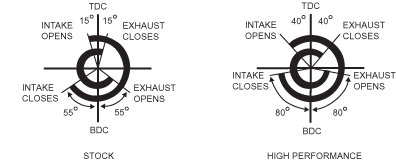

Manley Camshaft Tech Report "A Primer On Camshafts"

Choosing a camshaft and getting the best possible performance out of your vehicle, be it a street car, restored muscle car, street rod, hot rod, all out race car, boat or pulling truck, requires the proper combination of parts. The better your understanding of the inner workings of your engine, the better will be your ability to build an engine which will provide strong torque and horsepower and live in the demanding environment which it operates in. Camshaft selection plays a key part in racing and performance engine operation.
More Power with Proper Performance Racing Camshaft Selection, Timing and Installation
How to build high horsepower engines is an often asked question. We will try to help you be able to build a better engine by providing a series of tech articles that will help you better understand the inner workings of your internal combustion engine. The more you understand about building or rebuilding a stock, high performance or racing engine, the better prepared you will be to make the best purchasing decisions when buying parts for your project. The following article gives excellent information on how a camshaft operates and how it affects the performance of an internal combustion engine. This article is reprinted with permission from Manley Performance Products, Inc. We here at Campbell Enterprises thank Manley for allowing us to share this valuable information with our customers.
A PRIMER ON CAMSHAFTS
|

The illustration above shows the difference between the 4 cycle event with a stock camshaft and a high performance camshaft.
We sell the entire Manley Performance products line, including their top quality valvetrain components. We offer camshafts from many of the top camshaft manufacturers in the business like Competition Cams, Lunati, Speed Pro and more.
Please feel free to contact us for assistance with camshaft and valvetrain parts selection. We offer a wide range of camshafts and related parts, at reasonable prices, backed up with tech support and great customer service.
| Links to Manley Parts Pages on our site: |
copyright © Motorsports Parts Corporation T/A Campbell Enterprises. All rights reserved
 Item added to cart
Item added to cart